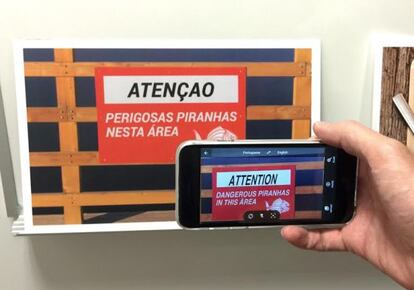Google Translate adds instant voice and sign translation
Services aim to let users hold conversations and read notices in foreign languages

Brazilian Otavio Good puts his smartphone on the table, presses a button and says a few words in his native Portuguese. Russian speaker Barak Turovsky, who is sitting across from him, waits a few seconds, and then hears a voice repeat the same words in his own tongue, to which he responds; his reply is in turn translated in the same robotic tones into Portuguese.
The colleagues, who normally use English to communicate, work for Google Translate on a language recognition project, and wanted to personally demonstrate their tool’s capabilities.
The technology is similar to what Skype unveiled a month ago, but the translating takes place in the same room; it doesn’t work in video conferences but in the real world, with two people present. It is not a new application, neither is it a service. In theory, it is simply an update of Google Translate, but could prove very useful in a variety of situations.
We know there are errors, but a bad translation is better than none at all” Google Translate’s Barak Turovsky
The innovation will soon be available for Android as well as Apple devices, but it is not the only one. Otavio Good joined Google in May of last year after the company bought his application Word Lens. The app allows you to point your phone at a sign in an unfamiliar language and have it instantly translated. It is ideal for reading plaques on monuments or restaurant menus, for example, and could also help you understand the front page of foreign newspapers, although it has problems with large chunks of text.
The system combines Optical Character Recognition, scanning and augmented reality technologies. It converts the image into a text, translates it and then superimposes it on the original, instantly.
Meanwhile, the oral translator uses machine learning, a technique from the field of artificial intelligence that imitates the way humans acquire knowledge. The more the app is used, the better its answers. The more data gets collected, the more likely it is to be right.
Turovsky estimates the voice translator’s success rate at around 80 percent. “We know there are errors, but a bad translation is better than none at all,” he says.
The system is not perfect, needless to say. Idiomatic expressions are particularly challenging, along with accents and other linguistic variations. Having said that, the two innovations provide considerable freedom for tourists or professionals on the move. “Having a conversation with a taxi driver or getting directions to go somewhere suddenly becomes very straightforward,” says Good.
Google Translate carries no advertising and makes no money for the company, yet is used by around half a billion people each month. Around 95 percent of them are outside the United States, with Mexico and Brazil among the biggest users.
For now, the voice translation service works in 36 languages. The sign translation is for now only available in English to Spanish, French, German, Italian, Portuguese and Russian, and vice versa. English is always either the original or the target language: so a sign written in Italian cannot be translated into French, for example.
Good and Turovsky say Google has no plans to start charging for the new services, and that it serves more than one billion translations a day.
Tu suscripción se está usando en otro dispositivo
¿Quieres añadir otro usuario a tu suscripción?
Si continúas leyendo en este dispositivo, no se podrá leer en el otro.
FlechaTu suscripción se está usando en otro dispositivo y solo puedes acceder a EL PAÍS desde un dispositivo a la vez.
Si quieres compartir tu cuenta, cambia tu suscripción a la modalidad Premium, así podrás añadir otro usuario. Cada uno accederá con su propia cuenta de email, lo que os permitirá personalizar vuestra experiencia en EL PAÍS.
¿Tienes una suscripción de empresa? Accede aquí para contratar más cuentas.
En el caso de no saber quién está usando tu cuenta, te recomendamos cambiar tu contraseña aquí.
Si decides continuar compartiendo tu cuenta, este mensaje se mostrará en tu dispositivo y en el de la otra persona que está usando tu cuenta de forma indefinida, afectando a tu experiencia de lectura. Puedes consultar aquí los términos y condiciones de la suscripción digital.
Últimas noticias
Most viewed
- Pablo Escobar’s hippos: A serious environmental problem, 40 years on
- Why we lost the habit of sleeping in two segments and how that changed our sense of time
- Charles Dubouloz, mountaineering star, retires at 36 with a farewell tour inspired by Walter Bonatti
- Reinhard Genzel, Nobel laureate in physics: ‘One-minute videos will never give you the truth’
- The Florida Keys tourist paradise is besieged by immigration agents: ‘We’ve never seen anything like this’








































